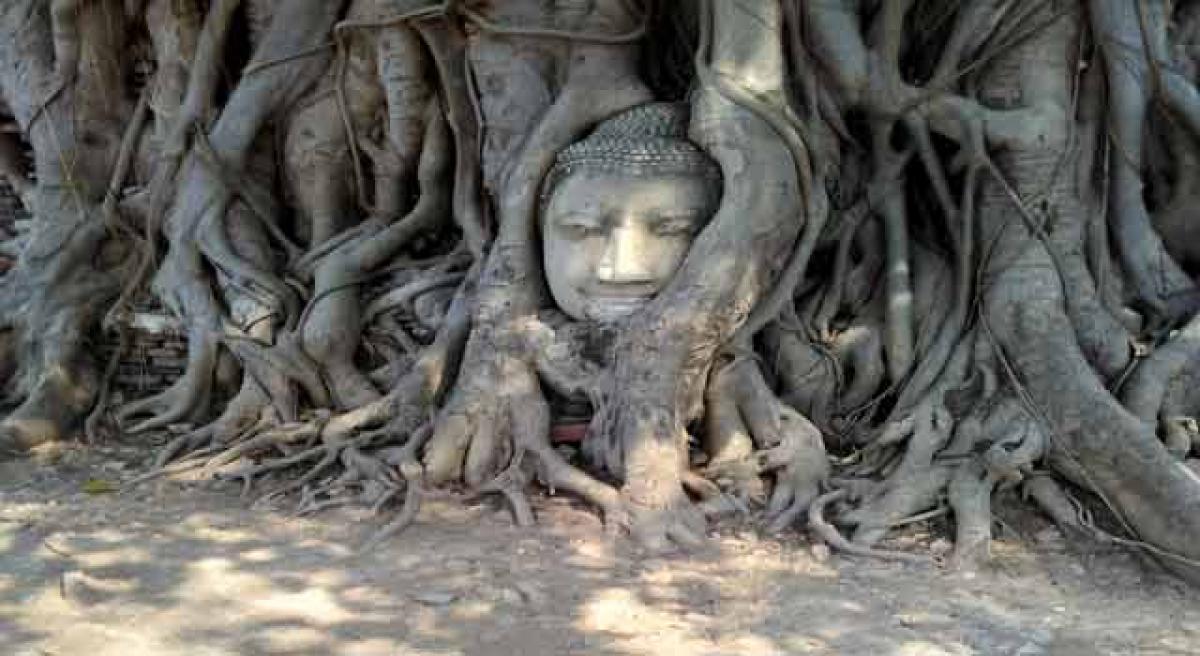Live
- Delhi Police busts gang involved in cable theft on Delhi Metro Blue Line
- MP's Gita recitation programme finds place in Guinness World Records
- Pawan Kalyan Shines Globally as 2nd Most Googled Actor of 2024 Amid Busy Film, Political Career
- Disruptor of House is the chairman himself: Cong and INDIA bloc’s pointed remarks on No-trust notice
- IIIT-Bangalore to host computer vision conference ICVGIP 2024
- F1: Fernando Alonso ‘still dreaming’ of third world championship
- WI vs Bangladesh Watch Controversial Banter Between Shakib and King
- EFLU Celebrates Bharatiya Bhasha Diwas
- Manchu Manoj Submits Bond of Rs. 1 Lakh to Rachakonda Commissioner
- Cuba denounces US 'theft' of Havana Club rum trademark
Just In

After lunch at a riverside restaurant at modern-day Ayutthaya, the visit to the once flourishing temple city was an enriching experience. Founded in 1350, Ayutthaya was the second capital of the Siamese kingdom. It was a global centre of economics and trade, and an important connecting point between the east and the west.
After lunch at a riverside restaurant at modern-day Ayutthaya, the visit to the once flourishing temple city was an enriching experience. Founded in 1350, Ayutthaya was the second capital of the Siamese kingdom. It was a global centre of economics and trade, and an important connecting point between the east and the west.
The Ayutthaya royal court exchanged ambassadors across the world, including with the French court at Versailles, the Mughal court in Delhi and the imperial courts of Japan and China. Right at the entrance of the site, a plaque gives an idea of what it holds. "Wat Mahathat (The royal temple that houses Buddha's relics)," it reads.
It is situated in the east of the Royal Palace in Pratu Chai sub-district, Phra Na Korn Sri Ayutthaya district, Phra Na Korn Sri Ayutthaya Province."It also stated that the construction of Wat Mahathat's main pagoda was started by King Boromaracha I in 1374 and completed in King Ramesuan's reign.
"The pagoda collapsed during King Songtham's reign and was renovated in 1633, after King Prasat Thong ascended to the throne."
This magnificent city was razed to the ground by invading Burmese forces in the 18th century. "At the fall of Ayutthaya in 1767, the monastery was set on fire in the Burmese attack," the plaque further reads.
"The abandoned pagoda fell into decay during the reign of King Rama VI. Only the symmetrical base with staircases remains."
"See here," said a Thai acquaintance, "the Burmese chopped off the heads of all the statues so that people cannot revere it as a temple city."
Indeed, it was a macabre sight, the elegantly carved statues in front of a Buddha statue, all without the heads. According to the Unesco website, Ayutthaya flourished from the 14th to the 18th centuries, during which time it grew to be one of the world's largest and most cosmopolitan urban areas and a centre of global diplomacy and commerce.
"Ayutthaya was strategically located on an island surrounded by three rivers connecting the city to the sea," the Unesco website reads.
"This site was chosen because it was located above the tidal bore of the Gulf of Siam as it existed at that time, thus preventing attack of the city by the sea-going warships of other nations. The location also helped to protect the city from seasonal flooding."
One can indeed make out the sheer ingenuity that went into the building of this historic city that is spread over an area of 289 hectares.
One highlight of the site is the head of a Buddha statue among the roots of a tree. "The head was once part of a sandstone Buddha image which fell off the main body on to the ground," a plaque alongside reads. "It was gradually trapped into the roots of a constantly growing Bodhi tree. The stone head has rather flat and wide facial structure with thick eyebrows and big eye lids, straight wide lip, and discernible lip edge, reflecting the art of Middle Ayutthaya Period, presumably around the mid of 1600s."
Then there are the cloisters - two layers of brick walls surrounding the main pagoda. According to a plaque outside these, the cloister is connected with the end of the ordination hall and the royal sermon hall which is an architectural style of the Early Ayutthaya Period. The overall city was laid out in a systematic grid and comprised roads, canals and moats. In 1991 it was declared as a Unesco World Heritage Site.
By: Aroonim Bhuyan

© 2024 Hyderabad Media House Limited/The Hans India. All rights reserved. Powered by hocalwire.com







